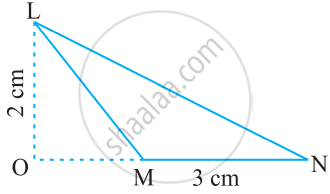Advertisements
Advertisements
प्रश्न
Prove that the points (2,3), (-4, -6) and (1, 3/2) do not form a triangle.
उत्तर
The distance d between two points `(x_1,y_1)` and `(x_2,y_2)` is given by the formula
`d = sqrt((x_1 - x_2)^2 + (y_1 - y_2)^2)`
In any triangle the sum of lengths of any two sides need to be greater than the third side.
Here the three points are A(2, 3), B(-4, -6) and C(1, 3/2)
Let us now find out the lengths of all the three sides of the given triangle.
`AB = sqrt((2 + 4)^2 + (3 + 6)^2)`
`= sqrt((6)^2 + (9)^2)`
`= sqrt(36 + 81)`
`AB = sqrt(117)`
`BC = sqrt((-4 -1)^2 + (-6 - 3/2)^2)`
`= sqrt((-5)^2 + ((-15)/2)^2)`
`= sqrt(25 + 225/4)`
`BC = sqrt(81.24)`
`AC = sqrt((2 - 1)^2 + (3 - 3/2)^2)`
` = sqrt((1)^2 + (3/2)^2)`
`= sqrt(1 + 9/4)`
`AC = sqrt(3.25)`
Here we see that, BC + AC not greater than AB
This is in violation of the basic property of any triangle to exist. Therefore these points cannot give rise to a triangle.
Hence we have proved that the given three points do not form a triangle.
APPEARS IN
संबंधित प्रश्न
Find the values of k so that the area of the triangle with vertices (k + 1, 1), (4, -3) and (7, -k) is 6 sq. units.
Find the area of the triangle ABC with A(1, −4) and mid-points of sides through A being (2, −1) and (0, −1).
Prove that the points (a, 0), (0, b) and (1, 1) are collinear if `1/a+1/b=1`
The point A divides the join of P (−5, 1) and Q(3, 5) in the ratio k:1. Find the two values of k for which the area of ΔABC where B is (1, 5) and C(7, −2) is equal to 2 units.
prove that the points A (7, 10), B(-2, 5) and C(3, -4) are the vertices of an isosceles right triangle.
Show that the following points are collinear:
(i) A(2,-2), B(-3, 8) and C(-1, 4)
Find a relation between x and y, if the points A(x, y), B(-5, 7) and C(-4, 5) are collinear.
Find the area of the following triangle:

The value of the determinant `abs((1,"x","x"^3),(1,"y","y"^3),(1,"z","z"^3))` is ____________.
Find the missing value:
| Base | Height | Area of parallelogram |
| ______ | 8.4 cm | 48.72 cm2 |
